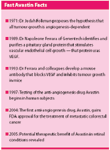Is Avastin the future?
Investigators caused a stir at the 23rd Annual Meeting of the American Society of Retina Specialists (ASRS) in Montreal, Canada, when they hinted at a potential use of bevacizumab (Avastin) in neovascular age-related macular degeneration (neovascular AMD).

Bevacizumab is a humanized monoclonal antibody that targets vascular endothelial growth factor (VEGF) and was the first treatment of its kind to be approved for the treatment of metastatic colorectal cancer (mCRC). Heralded as a breakthrough in cancer research and treatment, bevacizumab targets VEGF which stimulates tumour vascularization (angiogenesis) thereby inhibiting a tumour's blood supply and preventing tumour growth.
As VEGF is also implicated as one of the major growth factors responsible for choroidal neovascularization (CNV), clinical trials to elucidate the role of anti-VEGF treatments in retinal conditions have been conducted and yielded promising results so far.
The SANA (Systemic Avastin for Neovascular Age-Related Macular Degeneration) study has indeed shown there is a potential for off-label use of systemic bevacizumab in the treatment of neovascular AMD, when results showed treatment with the agent resulted in stable or improved visual acuity after 3 months in 15 patients. These results were significant in that they further supported a role for VEGF inhibition in AMD even when administered systemically.
Although bevacizumab appeared to be well-tolerated, intravenous administration of bevacizumab in mCRC patients has been associated with a high incidence of severe adverse events including hypertension, proteinuria, gastric perforation and bleeding.
Naturally, when investigators suggested intravitreal administration of bevacizumab as a potential therapy for neovascular AMD and macular oedema from a central retinal vein occlusion (CRVO), excitement grew. Although intravitreal bevacizumab has shown promise in only a few patients to date, the treatment appeared to be effective.
Philip J. Rosenfeld, MD and colleagues, from the Bascom Palmer Eye Institute in Miami, have described the first patients ever treated with intravitreal bevacizumab for neovascular AMD and macular oedema secondary to CRVO in the July/August 2005 issue of Ophthalmic Surgery, Lasers & Imaging. Although both articles are case reports conducted in an individual patient, the impact that both reports have had has been immense. Rosenfeld and his team have managed to expose a more favourable, potentially less toxic, way of administering an already approved therapy to a population of patients, many of whom, are still inadequately served by current therapies.
Intravitreal bevacizumab in macular oedema from CRVO
Rosenfeld and colleagues administered intravitreal bevacizumab to a 68-year old man who had developed macular oedema secondary to CRVO. The patient had previously received repeat injections of triamcinolone acetonide over a time period, which did have a beneficial effect on the patient, though this was a short-lived effect.

One week following intravitreal injection of bevacizumab, the patient presented an improvement in vision, with no evidence of inflammation. This improvement was maintained four weeks post-injection.
Although premature, these data strongly suggest a role for VEGF inhibition in macular oedema from CRVO and a role for bevacizumab in its inhibition. As bevacizumab is unlikely to cause glaucoma or cataract progression, induce retinal toxicity or cause the formation of floaters (a common complaint following triamcinolone acetonide therapy), should it prove to be an effective treatment for macular oedema from CRVO, physicians may opt for this therapy over existing available treatments, such as triamcinolone acetonide.
Intravitreal bevacizumab for neovascular AMD
